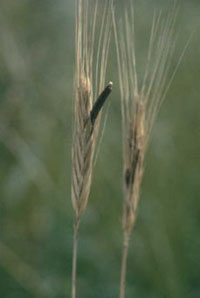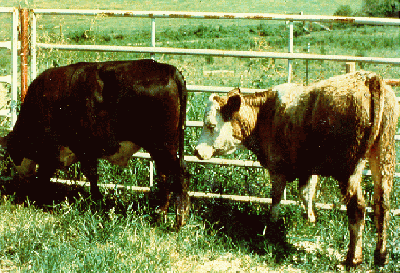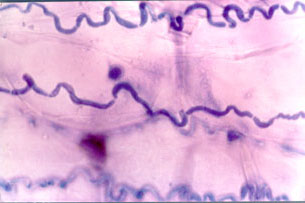 The
Fescue Diagnostic Laboratory was implemented in 1983 to serve
the needs of Alabama cattle producers who needed to have pastures
and seed of tall fescue tested for the presence of the endophyte
which causes "fescue toxicosis" in cattle. The rough
hair coat and poor weight gain characteristic of this problem
can be seen in the steer on the right, compared to the healthy
steer on the left.
This
Neotyphodium coenophialum, formerly Acremonium
coenophialum, is a fungus which lives within some fescue
plants and produces ergot alkaloids. The dark serpentine lines
on the picture below shows the fungus growing inside the tissues
of a fescue plant.
Most
livestock grazing endophyte infected fescue or ryegrass can
develop some form of fescue toxicosis. Broodmares have special
problems foaling when they graze endophyte-infected pastures.
(See the links section below for a complete explanation of
fescue toxicosis). Ergot alkaloids are also produced by the
ergot fungus, Claviceps which can infect almost any
grass species including such cereal grains as as rye and sorghum.
| Claviceps
purpurea on rye |
Claviceps
africana on sorgum in South
America |
 |
 |
We
accept samples from anyone, anywhere, and our clients have
included cattlemen, horsemen, diverse other livestock owners,
seed producers, veterinarians, consultants, and other researchers
with specific needs.
Taking a Sample for
Endophyte Testing
Pastures
may be tested at any time when the plants are growing, but
it is important that the sample represent the pasture being
tested. The tiller, or stem, of the plant is a good part of
the plant to test. Cover as much of the pasture as possible,
stopping at intervals to take one
tiller from a plant at each of at least 50 locations. Take
the lowest 3-4 inches of the tiller, removing any soil or
long leaf blades. Remember, we need the
stem or tiller to test.
Be sure that plants are fescue and not orchardgrass or ryegrass,
which are similar in appearance. Plants in flower may also
be sampled by taking at least 50 culms or stems which bear the flowers. Again, be sure to
sample from different widely separated plants, and include
the flowers. This will also aid in identification of the plants.
Wrap the plant material in a slightly damp paper towel, place
in a plastic bag, and mail so that it arrives within 2-3 days.
Avoid a weekend mailing, especially in hot weather.
Seeds for testing should be taken from many different bags in the
seed lot, or taken with a probe if the seed are in a storage
bin. The seed should be dry, and no other special handling
or mailing precautions are needed. Two tests are available
for seeds, the stain test and the growout test. Staining
will reveal the presence and amount of endophyte, but not
viability of the fungus. The growout test will reveal whether
the fungus is alive and infective, but it takes longer and
costs a little more.
Within a
few weeks we will report back to you the percentage of plants
or seeds which were infected, along with a recommendation
for your livestock based on the best available research information.
Current Schedule of
Fees
To send us
a sample, you can use this form. (To print form: Point to the form and
click the mouse. Go to the menu bar, click File then Print
from your web browser.
 We can mail the following literature to you, just
drop us an email.
We can mail the following literature to you, just
drop us an email.
- Fescue Diagnostic Lab Brochure: Explains sampling,
mailing, fees, etc. in more detail.
- Tall Fescue/Endophyte/Animal Relationships:
Explains effects of infected fescue on Cattle and Horses.
If you wish to contact us by snail mail:
Fescue Diagnostic Laboratory
209 Life Science Building
Auburn University, AL 36849-5409
Want to Know More?
Visit these sites:
<< top
|



